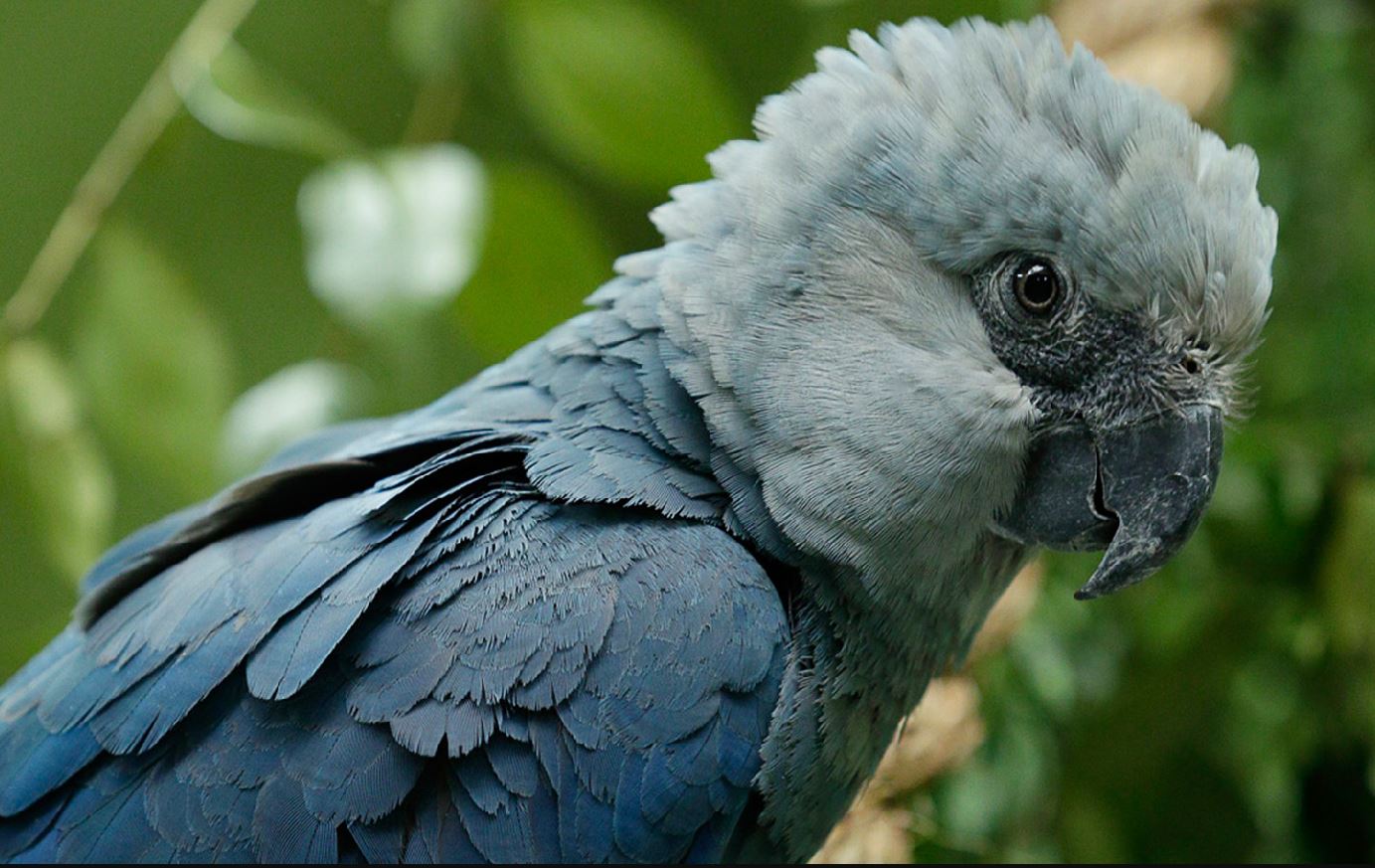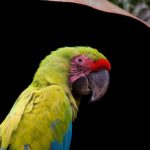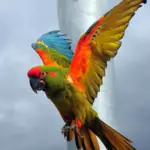
Spix’s Macaw
(Cyanopsitta spixii) is a species of bird considered to be extinct in the wild (a bird was however filmed in 2016) belonging to the Psittacidae family. It was named after the German zoologist and explorer Johann Baptist von Spix (1781-1826).
In September 2018, the NGO Birdlife International announced that the species is extinct in the wild1,2.
In June 2018, a partnership agreement concerning a vast program to reintroduce the Macaw Spix in its natural environment was concluded at Pairi Daiza park (Belgium) 3.
This brings together the Brazilian Ministry of the Environment, the Pairi Daiza Foundation, the Chico Mendes Institute for Biodiversity Conservation (Brazil), and the Association for the Conservation of Threatened Parrots (de) (Germany). Reintroduction into the wild is planned for 2019-20204
This macaw measures 55 to 60 cm in length for a weight of 340 to 350 g, entirely blue, slightly greenish on the chest and the belly. The head is light gray tinged with blue and the beak blackish.
spix’s macaw population 2021
where are Spix macaws found:
The Spix’s Macaw is said to have been discovered by a Dutch settler in the 17th century, but it was not studied until the beginning of the following century by Johann Baptist Ritter Von Spix the German naturalist.
The name was subsequently given to this species in his honor. As for its description, it is attributed to the German zoologist Johann Georg Wagler, who would have made it in 1832.
At that time, the numbers of Spix’s Macaw were already quite low, estimated at less than 200 individuals.
Poaching and the destruction of its natural habitat have made this animal even rarer. Despite a law protecting the species that came into force in Brazil in 1967, individuals continued to be captured.
No Spix’s Macaw could be observed in the wild until 1985 when 5 birds were seen (5 including 2 pairs), but they also ended up being victims of poaching.
5 years later, Brazil set up the Standing Committee for the Restoration of the Spix’s Macaw. Efforts were made to promote breeding in captivity, but problems with inbreeding soon emerged.
Now, this species is considered extinct in the wild. A male was however seen in 2016. Captive birds, which number in the dozens, live in the Canary Islands, Qatar, and Germany, in addition to Brazil.
On March 3, 2020, 52 Spix’s Macaws arrived in Brazil from Germany. They lived at the Breeding and Breeding Center of the Association for the Conservation of Endangered Parrots (ACTP) in Berlin.
The decision was made to reintroduce them into their natural environment in 2021 in two popular reserves specially created by the Brazilian authorities.
what do macaws eat
The Spix’s Macaw feeds mainly on seeds and peanuts from non-endemic plants from Brazil, including Paranà pine nuts and Cnidoscolus quercifolius which have been introduced from Argentina.
The first is a critically endangered tree, the massive exploitation of which has contributed to the reduction of the natural pantry of the Macaws of Spix.
There are also many other peanuts and seeds like Baraùna, Facheiro, and all the plants of the Phoradendron family.
Spix Macaw on brink of extinction
SOURCE: Al Jazeera English
Spix’s macaw price
Only 4 Spix’s macaws survived in the wild and collectors were willing to pay astronomical sums (up to $50,000) for the purchase of the last specimen
where do macaw live
spix’s macaw habitat:
The Spix’s Macaw lives in gallery forests within the “caatingas” (scrubby, thorny, dry, and flat moors along seasonal watercourses), with several varieties of trees, cacti, Euphorbiaceae, and other plants, particularly the “Tabebuia caraiba” tree used for nesting. Its natural habitat is very restricted along these temporary waters.
This macaw once lived in the Sao Francisco River Valley in northeast Brazil. This region is still maintained for the future reintroduction of the species, although it is even more restricted today.
Many years ago, when the Spix’s Macaw was a wild bird living in these gallery forests, the high-pitched cries emitted by the parrots echoed in these landscapes. Other sounds like the typical dry, rolling “kraa-aark” were heard between the trees, carried on the wind above the vegetation.
In the wild, the Spix’s Macaw is sedentary. It can perform some movements depending on the food resources and the availability of nesting sites. It also moves depending on the rainfall.
It uses the Tabebuia tree for resting and sleeping. This tree is about eight meters tall and bears yellow flowers at the end of the dry season.
It is because of its dependence on this tree that the Spix’s Macaw has a very restricted natural habitat.
These parrots are seen in pairs or in small groups.
They are shy birds, flying away when an intruder approaches. It performs flapping flight and has a distinct silhouette with its long tail.
Currently, the Spix’s Macaw has been extinct since the year 2000, when the last macaw disappeared. But very active breeding programs are underway to protect this species, with the hope of reintroducing it to its natural habitat one day soon.
The little blue macaw

Spix macaw natural habitat
spix’s macaw population
why are macaws endangered?
Although fully protected by Brazilian law since 1967, the Spix Macaw was only rediscovered in the wild in 1985, when 5 birds (including 2 pairs) were located in the north of the state of Bahia.
Trappers had been active in the region for fifteen years, capturing at least 23 birds, even 40, and it seems that in 1988 the last 5 had been poached.
However, the last wild survivor was located in 1990. It was then realized that, if trapping was responsible for the recent scarcity of the species, its main cause was the destruction of the forests constituting its nesting habitat, of which there would not remain more than 30 km2.
In 1990, the Brazilian nature conservation authorities created a Standing Committee for the Restoration of the Spix’s Macaw, which brings together various interested parties, including most of the captive bird keepers, as well as representatives of international organizations. nature conservation.
Attempts have been made to improve the results of breeding in captivity, which has brought the number of captive macaws to more than 30 individuals;
but most of these are very related, which could lead to inbreeding problems. In addition, the question arises as to whether birds born in captivity have the capacity to really serve the interests of the species.
In fact, among macaws, relationships with their environment are based on learning and passing on traditions. It takes them years to discover the secrets of their environment, and it seems unlikely that birds born in captivity and belonging to an extinct species in the wild would be able, from scratch, to retrieve the information they have need.
In 1995, after analyzing the feathers of the Spix’s Macaw still at large, carried out with the aim of confirming its sex (male), a captive but wild female was released to join him.
However, the wild male had paired with a solitary Illiger Macaw, and although the released female encountered the male, they did not form a pair, possibly due to the Illiger Macaw, and therefore the female disappeared.
As for the male, he has not been seen since 2000 and is probably dead; according to IUCN, the species is therefore now probably extinct in the wild, and only survives in captivity.
The Scarlet Macaw has been listed in CITES Appendix I since its creation (this appendix I groups together the species whose status is so unfavorable that no form of trade is acceptable);
the private possession of this macaw has even been prohibited by Brazilian law since the 1960s, which did not prevent the last specimens from ending up in the hands of the richest collectors in the world. No legislation has by itself been able to help such a coveted species.
The few dozen individuals living in captivity are now present in Qatar, the Canary Islands (Spain), Germany, and Brazil itself. Coordination is currently in place to reconstitute a larger population by exchange of individuals.
On June 18, 2016, a Spix Macaw was seen and filmed in the wild in the Caatinga region in the state of Bahia, in the northeast of Brazil.
Spix macaw in captivity
Spix macaw breeding program:
If this project succeeds, it will mark the return of the Spix’s macaw to Brazil twenty years after its disappearance. Indeed, the last wild individual was seen in 2000, then none thereafter.
The International Union for Conservation of Nature ( IUCN ) classified the species as “extinct in the wild” (EX) and only a few survivors existed in captivity.
Without this genetic reservoir, it would never have been possible to imagine such a program. Declared extinct by Chinese scientists at the beginning of 2020, the Chinese swordfish of the Yangtze will for example not have this last chance since no individual lived elsewhere than in the wild and no sample of its DNA has been preserved.
It is thanks to captive Spix’s macaws that a breeding program was able to see the light of day. For security reasons, there are now three different places where these parrots live, the last representatives of their species, and only two are breeding successfully:
the ACTP center in Germany and ICMBio in Brazil. , which has been breeding the species since 2019. The third-place where Spix’s macaws live is at the Belgian zoo Pairi Daiza.
He also actively participated in the project by sending three individuals to Brazil, in addition to the 49 sent by the ACTP, and by financing the construction of the release center to the tune of 1.5 million euros.
Spix’s Macaw – a blue and bright sign of hope
SOURCE: ACTP e.V.
How much is a Spix’s macaw?
Spix’s macaws survived in the wild, and collectors were willing to pay astronomical sums (up to $50,000) for the purchase of the last specimen…
how many Spix’s macaws are left 2020?
There are currently around 150 “Ararinha Azul”, all in captivity. In Pairi Daiza, two macaws will remain visible to the public
what is the rarest macaw?
Spix’s Macaw is the rarest in the world




















